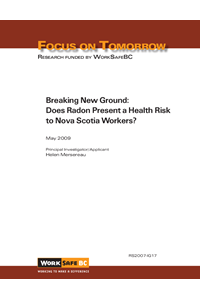Breaking New Ground: Does Radon Present a Health Risk to Nova Scotia Workers?
Research suggests there has been a lack of clarity concerning health risks for Nova Scotia workers exposed to radon exceeding the naturally occurring radioactive materials limit
Radon can move freely through small places in the soil and rock, enabling it to enter the atmosphere or seep into buildings through dirt floors, cracks in concrete walls or floors, sump pumps, joints, or basement drains. A previous assessment carried out in Nova Scotia showed that areas in the province are radon prone. As such, the research will aim to characterize its sources of entry and the levels of air concentrations within workplaces in Nova Scotia
This study assessed average radon levels in 21 workplaces in Nova Scotia. Radon is an invisible, odorless, radioactive gas released during the natural breakdown of uranium, which at high doses can increase the risk of lung cancer
The research results showed very low radon concentrations in 19 of the 21 workplaces. Two workplaces had individual locations with readings over 150 becquerels per cubic metre (Bq/m3), the level at which national guidelines indicate steps should be taken to manage worker exposure. However these were well below the level (800 Bq/m3) at which a Radiation Protection Management is advised
Possible explanations for the low radon levels found in this study include soil and water composition, good ventilation and well maintained building foundations
| Principal Applicant: | Helen Mersereau (Cape Breton University) |
| Co-applicant: | Arthur Scott (Arthur Scott &Assoc.) |
| Funding Awarded: | $26,100* (Innovation) |
In partnership with the WCB of Nova Scotia – budget fully supported by WCB of Nova Scotia

